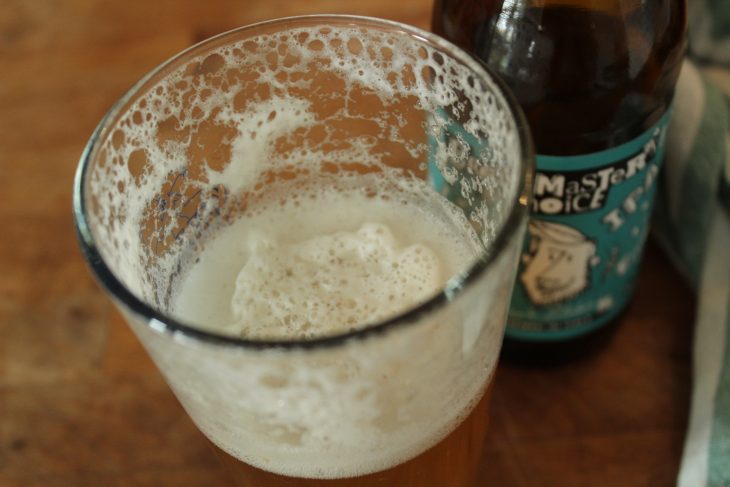Hey there! This site is reader-supported and we earn commissions if you purchase products from retailers after clicking on a link from our site.
Unless you go to beer halls and consider yourself a connoisseur of beer, you might not be familiar with the term “lacing.” What is beer lacing? Don’t worry, it’s not as problematic as it sounds. Lacing is a natural occurrence in some beers, which is why you should learn about it.
Guess what? We’ve got all the information you need to learn about beer lacing right now.
Before Beer Lacing Comes Foam
Most beer drinkers are familiar with foam. It’s usually there when you pop off the cap of your favorite beer and pour the liquid into a glass. The foamy white head appears.
Understanding the foam head is the first important step of describing beer lacing, because without foam, there’s no lacing.
Beer foam is formed through a process called nucleation, or the creation of bubbles. You also see nucleation in champagne and beer, present as carbon dioxide. But there is another element present that affects the foam head—Lipid Transfer Protein 1 (LTP1).
LTP1, being that it’s a protein for fats, tends to dislike water. A lot. In science, it’s called a hydrophobic protein. When beer is brewed, LTP1 takes a hold of carbon dioxide and rises with the bubbles to the surface of the beer. Consequently, the protein is going to hitch a ride whenever CO2 ascends; this creates and maintains the beer’s foam head.
What is Beer Lacing?
The foam head forms, you ogle it, take a picture for Insta, and then you start drinking. What happens? Some of the foam stubbornly sticks to the glass in lines, right? That is beer lacing.
How does that happen? LTP1 interacts with all kinds of compounds and proteins present on the glass, not just CO2. In other words, whatever isn’t liquid is going to attract LTP1, forming those characteristic lattice-like patterns inside the beer glass.

What Influences Lacing?
Will lacing happen every single time you pour beer? Yes and no. There are a couple of factors that influence lacing: the style of beer and whether the glass is clean. Cereals, mashes, and hops play a role in how much head your beer gets.
A clean glass prevents you from getting dirty beer and more head retention. Oils, soap, detergent, lipstick, chapstick, and grease will kill the foam head. If you rinse a glass for beer, be sure to let it dry without wiping it, because the lint from the bar towel could also affect the density of the foam.
The less foam, the less lacing. Also, if you tend to down your beer in a few gulps, there won’t be as much lacing. Drink it more slowly, though, and lacing will be obvious.
Reasons Why Some Beers Have More Foam
Ever wonder why your beer’s head is smaller than your friend’s? Here are some interesting things to consider about foam and lacing:
1. Alcohol Content
The more alcohol your beer has, the more foam and lacing you’ll see. If your beer is even slightly higher in ABV than your friends, your beer will probably have more foam.
2. Temperature
The temperature of beer influences how well it tastes, how attractive it looks, and how much foam you get. Sometimes the larger bubbles in beer will absorb the tinier ones. It’s a process called disproportionation, and it happens when beer is warmer. You get a spottier, less dense foam as a result.
In other words, cooler beers make better foam and more lacing.
3. Nitrogen
Anyone who drinks Guinness will understand the creamy and rich head that nitrogen produces. This makes the mouthfeel unparalleled and enjoyable.
Nitrogen gas is insoluble, meaning that it produces smaller bubbles and a stable head. You get distinctive rings that have become a part of the Guinness experience.
4. Carved Glassware
If the glass is carved at the bottom, it becomes a place where the bubbles stick and mass together, until there is enough buoyancy to break the bubbles free. In doing so, the foam gets replenished.
Embrace The Lacing
Now you know that beer lacing is residue left from the foamy head as you take gulps or sips. If your draft beer was poured to the brim, the foam is moving further down into the glass, leaving traces of it behind. Naturally, the more foam, the more lacing. And that’s not a bad thing! Unless you suspect the glass is dirty, of course.
FAQs About Beer Lacing
Beer lacing is caused by protein. The globular protein, LTP1, is hydrophobic (water-hating) and will cling to the CO2 present in foam. This causes the foam and protein to stick to the glass, creating lacing.
“Legs” has the same meaning with beer as it does with wine. What “having legs” refers to is the liquid that clings to the sides of the glass and runs down when the drink is swirled. High alcohol beers tend to have legs more often than standard beers.
The residue inside the beer glass is referred to as lacing. The slower a beer with foam is consumed, the more lacing you will spot.
There are many meanings out there for the term “dirty beer.” However, when we’re talking about beer for real, it gets dirty whenever the draft lines or glassware hasn’t been cleaned properly. Dirt and grime don’t play nice with beer, making it look and taste worse. So a dirty beer is when a dirty glass or lines also make the beer gross.

